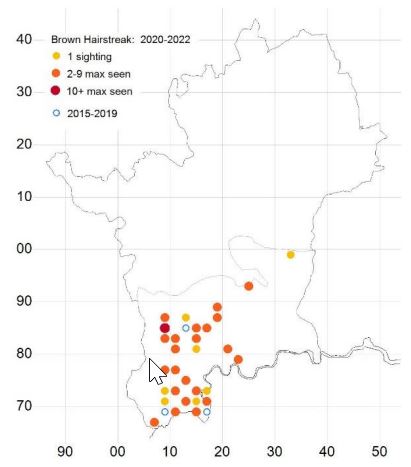
Distribution and Status The Brown Hairstreak has always been rare in our branch area. In the past, there were occasional reports of sightings in central Hertfordshire and Bricket Wood. Significant egg finds in Hampton, Richmond in December 2016 by Stephen Reisbach suggests possible expansion northwards from Surrey. Reports of eggs in Richmond and Hounslow in 2017-18 by Liz Goodyear and Andrew Middleton, and in Ickenham and Hayes by Paul Busby among others in 2018-19 seem to confirm the expansion. Adults or eggs have been seen in other areas in south-west Middlesex such as Cranebank LNR, Feltham and Hounslow Heath and there appears to be an expansion northwards to Fryent Country Park and beyond albeit in low numbers in some areas. There was an explosion of egg finds at Horsenden Hill in 2021-22. In 2022 there was a first record from Harrow in Newton Ecology Park. The occasional unconfirmed sightings in Hertfordshire in the last few years raise the possibility that there could be colonies in the county Habitat Requirements Woodlands and hedgerows containing blackthorn are required for this elusive butterfly to breed Larval Foodplants Blackthorn Prunus spinosa. Sometimes other Prunus ssp. are used Adult Food Sources Bramble Rubus fruticosis agg., Common Fleabane Pulicaria dysenterica, Hemp Agrimony Eupatorium cannabinum. Honey-dew Behaviour/Observation notes The Brown Hairstreak is a very secretive butterfly and is therefore difficult to find so many organisations are now using egg-hunts to monitor populations as the white eggs are far easier to locate once it is known where they are likely to be. The females tend to stick to the same egg-laying sites year by year, selecting sunny and sheltered spots and usually lay eggs singly on blackthorn twigs of suckering growth in the early to mid afternoon. Males, on the other hand, hold territories high up in the tree canopy, usually around a tall ash tree. Because of the females' egg-laying and feeding habits, they are the easier sex to find and are more likely to be seen between around midday and 15:00 hours. Andrew Middleton and Liz Goodyear undertook some research on male territorial behaviour - see notes under Futher Information below 
Life History Male adults start emerging in late July but it is usually in the middle of August for females. The white eggs can be searched throughout the winter on the foodplant before they hatch in spring. The green larvae feed at night and rest on the underside of a leaf by day. When fully grown, they will descend to the ground to pupate Further information
Photo gallery |